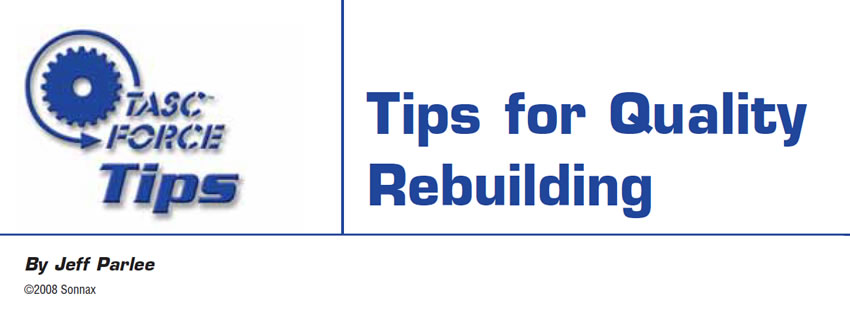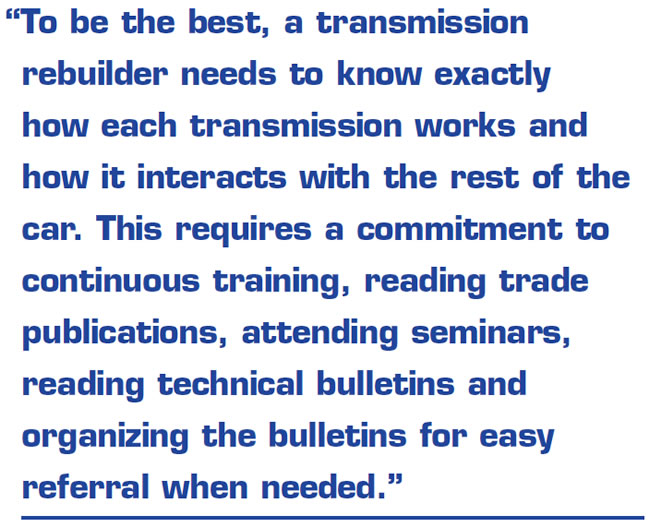
TASC Force Tips
- Author: Jeff Parlee
Have you ever wondered why some rebuilders never seem to have a comeback? Their units are installed, test driven and delivered time after time without any problems. Their success is the result of a combination of things that any transmission rebuilder with motivation and good skills can do.
Most rebuilders who are truly good have decided somewhere along their career that they wanted to be the best. That means they are on a constant quest for knowledge. To be the best, a transmission rebuilder needs to know exactly how each transmission works and how it interacts with the rest of the car. This requires a commitment to continuous training, reading trade publications, attending seminars, reading technical bulletins and organizing the bulletins for easy referral when needed.

Good transmission rebuilders sweat the small stuff. In other words, be meticulous! Experienced rebuilders don’t neglect the basics to save time. Good rebuilders do all the little things that make the unit work right the first time. They check all the flat surfaces for valleys and high spots, air-check components as they assemble the transmission, address weak areas in the transmission, check all clearances and always use a torque wrench during assembly.
When disassembling a transmission the rebuilder should be looking for the root cause of the transmission failure. Sometimes it can be as simple as a low-fluid condition because of a leak. Other times it requires a good diagnostic evaluation before the transmission is removed to help find the root cause. If you don’t locate the root cause before reassembly, you are building an eventual comeback or no-go.

Here are some rebuilding tips that will help you eliminate some common problems:
- Replace the bushings. Bushings keep the rotating parts running true and the lube oil flowing where it is needed. Some bushings are also used to seal off pressure just as a sealing ring would. Have you ever noticed that some bushings have lube grooves cut into them and others don’t? Bushings that have no lube grooves are sealing oil pressure. On many transmissions the front-stator-support bushing seals converter-apply oil. A leak at this bushing could give you TCC-slip codes or improper converter-clutch operation.
- Set unit endplay. Correct endplay will reduce bearing and gear-train noises.
- Clutch clearance and band adjustments are critical to proper operation and durability. When no clutch-clearance value is available, the rule of thumb is 0.008-0.010 inch per friction. Example: A clutch pack that has six frictions will have a clearance of 0.048-0.060 inch.
- Carefully check the air-bleed checkballs and seats on clutch pistons and drums. The checkballs should not leak when seated, not stick on the seat and be free of dirt and debris.
- Check all flat surfaces (cases, valve bodies, pump halves, governors) for flatness. A large mill file works well on steel, like pump halves, and large areas like the case. Remember not to drag the file back over the work after taking a cut. Doing this will dull the file and damage the surface you are trying to make flat. I prefer to flat-sand valve bodies on a granite block to get the flattest surface. Cross leaks due to warped parts or high/low spots on flat surfaces where oil passages are located can cause a multitude of difficult-to-diagnose problems. These problems can be avoided!
- Check clutch pressure plates: They must be flat.
- Check pump clearances and pump wear. When hot, many late-model transmissions will set converter-slip codes because of low pump volume.
- Soak all friction clutches and bands in ATF for 15 minutes. Soaking the friction materials ensures that heat will be dissipated during initial operation and not glaze the friction surface.
- Lubricate the transmission with ATF during assembly. Pay special attention to bushings, bearings, planetary gears, thrust washers and the pump.
- Use a torque wrench when assembling the transmission. Valve bodies work much better when they are evenly torqued.
- Check all solenoids electrically and hydraulically. All switches should be checked for proper operation. Don’t forget to check oil-pressure switches for leaks.
- Always use a Scotch-Brite™ pad to remove the glazing from aluminum accumulator bores when rubber seals are used on the accumulator piston.
- Always bore-fit sealing rings.
- Check the gasket surface on pans for high spots around the bolt holes. These high spots need to be tapped down so the gasket surface is flat.
- Check servo bores in the case for damage, especially the pin bore for wear. When checking a servo bore that uses a rubber molded piston, you can get the false impression that the bore feels tight. Always grind off the rubber on the piston far enough that the rubber is not contacting the servo bore. This will allow you to feel any play between the pin and bore. Save the ground-down piston to use as a tool.
- Check accumulator pistons and pins for wear. Remember, wear equals leaks in that hydraulic circuit.
- Air-check the transmission at every step of the assembly process.
- Keep your reference materials and tech bulletins organized and close by for easy access.
Change is a way of life in the automotive industry. Make a commitment to yourself today to be open to new ideas and technology. If you follow these simple steps while rebuilding, your aggravation level will go down and the job will be more rewarding.

Jeff Parlee is director of product support at ValveBody Xpress and a member of the TASC Force (Technical Automotive Specialties Committee), a group of recognized industry technical specialists, transmission rebuilders and Sonnax Industries Inc. technicians. ©2008 Sonnax













